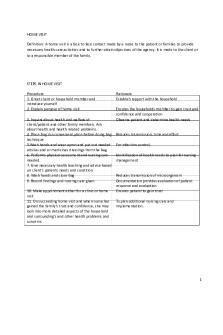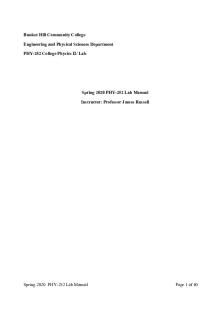Lab Manual RLE Retdem Questions Eyes PDF

| Title | Lab Manual RLE Retdem Questions Eyes |
|---|---|
| Author | Ellie Eileithyia |
| Course | Education |
| Institution | Laguna State Polytechnic University |
| Pages | 5 |
| File Size | 138.4 KB |
| File Type | |
| Total Downloads | 40 |
| Total Views | 158 |
Summary
Download Lab Manual RLE Retdem Questions Eyes PDF
Description
Health Assessment Questions – Eyes (Lab Manual)
Nursing Interview Guide to Collect Subjective Data from the Client Questions
Findings Current Symptoms
1. Recent changes in vision? 2. Spots or floaters in front of eyes? 3. Blind spots, halos, or rings around lights?
4. Trouble seeing at night? 5. Double vision? 6. Eye pain? 7. Redness or swelling in eyes? 8. Excessive watering or tearing or other discharge from eyes?
Past History Previous eye or vision problems (medication, surgery, laser treatment, corrective lenses)
Family History 1. Family history of eye problems or vision loss?
Lifestyle and Health Practices 1. Exposure to sun or chemicals, fumes, smoke, dust, flying spark, etc.? 2. Use of safety glasses? 3. Uses of sunglasses?
4. Medications (corticosteroids, lovastatin, pyridostigmine, quinidine, and rifampin) may have ocular side effects?
5. Has vision loss affected ability to work or care for self or others?
7. Have glasses or contacts? Are they worn regularly?
Performing Assessment Guide to Collect Objective Client Data Questions
Findings
1. Gather equipment (gloves, exam light, penlight, magnifying glass, centimeter ruler, wood lamp if available) 2. Explain procedure to patient
Perform Vision Tests 1. Distant visual activity (with Snellen chart, normal acuity is 20/20 with or without corrective lenses)
2. Near visual acuity (with a handheld vision chart, normal acuity is 14/14 with or without corrective lenses)
3. Visual fields (use procedure discussed in textbook to test peripheral vision).
Perform Extraocular Muscle Function Tests
1. Corneal light reflex (using a penlight to observe parallel alignment of light reflection on corneas)
2. Cover test (using an opaque card to cover an eye to observe for eye movement)
3. Positions test (observing for eye movement)
External Eye Structures 1. Inspect eyelids and lashes (width and position of palpebral fissures, ability to close eyelids, direction of eyelids in comparison with eyeballs, color, swelling, lesions, or discharge)
2. Inspect positioning of eyeballs (alignment in sockets, protruding or sunken)
3. Inspect bulbar conjunctiva and sclera (clarity, color, and texture)
4. Inspect palpebral conjunctive (eversion of upper eyelid is usually performed only with complaints of eye pain or sensation of something in eye). 5. Inspect lacrimal apparatus over lacrimal glands (lateral aspect of upper eyelid) and the puncta (medial aspect of lower eyelid). Observe for swelling, redness, or drainage.
6. Palpate lacrimal apparatus, noting drainage from the puncta when palpating the nasolacrimal duct.
7. Inspect the cornea and lens by shining a light to determine transparency
8. Inspect iris and pupil for shape and color of iris and size and shape of the pupil 9. Test pupillary reaction to light (in a darkened room, have client focus on a distant object, shine a light obliquely into the pupil, and observe the pupil’s reaction to light—normally, pupils constrict) 10. Test accommodation of pupils by shifting gaze from far to near (normally, pupil constricts)
Internal Eye Structure 1. Inspect the red reflect by using an ophthalmoscope to shine the light beam toward the client’s pupil (normally, a red reflex is easily seen and should appear round with regular borders). 2. Inspect the optic disc by using the ophthalmoscope focused on the pupil and moving very close to the eye. Rotate the diopter setting until the retinal structures are in sharp focus (observe disc for shape, color, size, & physiologic cup). 3. Inspect the retinal vessels using the above technique (observe vessels for numbers of sets, color, diameter, arteriovenous ration, and arteriovenous crossings). 4. Inspect the retinal background for color and presence of lesions 5. Inspect fovea and macula for lesions 6. Inspect anterior chamber for transparency
Analysis of Data
1. Formulate nursing diagnoses (health promotion, risk, actual)
2. Formulate collaborative problems
3. Make necessary referrals...
Similar Free PDFs

Ch 11 Eyes Questions
- 23 Pages

Community Health Nursing RLE
- 15 Pages

Eyes-Wide-Shut - Eyes-Wide-Shut
- 96 Pages

BAG- Technique - RLE Bag
- 7 Pages

Dolls eyes
- 2 Pages

CN-Lab-Manual - Full Lab Manual
- 34 Pages

Lab manual
- 49 Pages

Lab Manual
- 60 Pages

IMH-LAB- Manual manual manual
- 21 Pages

Lab questions - lab report
- 2 Pages

ECE235 Lab Manual lab work
- 53 Pages

DLD LAB 1 - Lab manual
- 7 Pages

LAB Fisica 4 - Manual lab
- 58 Pages
Popular Institutions
- Tinajero National High School - Annex
- Politeknik Caltex Riau
- Yokohama City University
- SGT University
- University of Al-Qadisiyah
- Divine Word College of Vigan
- Techniek College Rotterdam
- Universidade de Santiago
- Universiti Teknologi MARA Cawangan Johor Kampus Pasir Gudang
- Poltekkes Kemenkes Yogyakarta
- Baguio City National High School
- Colegio san marcos
- preparatoria uno
- Centro de Bachillerato Tecnológico Industrial y de Servicios No. 107
- Dalian Maritime University
- Quang Trung Secondary School
- Colegio Tecnológico en Informática
- Corporación Regional de Educación Superior
- Grupo CEDVA
- Dar Al Uloom University
- Centro de Estudios Preuniversitarios de la Universidad Nacional de Ingeniería
- 上智大学
- Aakash International School, Nuna Majara
- San Felipe Neri Catholic School
- Kang Chiao International School - New Taipei City
- Misamis Occidental National High School
- Institución Educativa Escuela Normal Juan Ladrilleros
- Kolehiyo ng Pantukan
- Batanes State College
- Instituto Continental
- Sekolah Menengah Kejuruan Kesehatan Kaltara (Tarakan)
- Colegio de La Inmaculada Concepcion - Cebu


